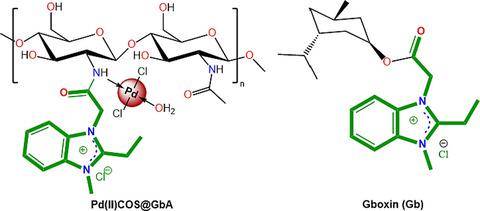当前位置:
X-MOL 学术
›
Chem. Bio. Drug Des.
›
论文详情
Our official English website, www.x-mol.net, welcomes your
feedback! (Note: you will need to create a separate account there.)
Role of Pd(II)-chitooligosaccharides-Gboxin analog in oxidative phosphorylation inhibition and energy depletion: Targeting mitochondrial dynamics.
Chemical Biology & Drug Design ( IF 3.2 ) Pub Date : 2020-05-13 , DOI: 10.1111/cbdd.13703 Serag Eldin I Elbehairi 1, 2 , Mohammad Y Alfaifi 1 , Ali A Shati 1 , Mohammed A Alshehri 1 , Reda F M Elshaarawy 3, 4 , Hani S Hafez 5
Chemical Biology & Drug Design ( IF 3.2 ) Pub Date : 2020-05-13 , DOI: 10.1111/cbdd.13703 Serag Eldin I Elbehairi 1, 2 , Mohammad Y Alfaifi 1 , Ali A Shati 1 , Mohammed A Alshehri 1 , Reda F M Elshaarawy 3, 4 , Hani S Hafez 5
Affiliation

|
In this work, we have successfully upgraded the crab wastes into Pd(II) complex of Gboxin analog–chitooligosaccharides conjugate (Pd(II)COS@GbA). This new complex has a high capacity to inhibit the proliferation of prostate cancer cells (IC50 = 1.92 μg/ml). This activity could be attributed to its ability to induce mitochondrial fragmentation through increasing mitochondrial fission dynamin‐related protein 1 (p < .05) and down‐regulation of optic atrophy 1 proteins (p < .05). Moreover, this complex can effectively disrupt ATP synthase action leading to declined ATP production, along with downstream of ATPase inhibitor factor1 that hinder energy production in the cancer cells. Also, it has an anti‐inflammatory effect by triggering modulators for the release of inflammatory molecules such as TNF‐α (p < .05), IL‐6 (p < .05), and mRNA transcripts of COX‐II (p < .01). Therefore, Pd(II)COS@GbA exhibited significant anti‐prostate cancer activity through different mechanisms in inducing energy depletion and mitochondrial fragmentation leading to disrupted oxidative phosphorylation (OXPHOS). Complex Pd(II)COS@GbA is more cytotoxic for PC3 than RWPE‐1 which in turn means it is may act as a selective cytotoxic agent for prostate cancer.
中文翻译:

Pd(II)-壳寡糖-Gboxin类似物在氧化磷酸化抑制和能量消耗中的作用:靶向线粒体动力学。
在这项工作中,我们已成功地将螃蟹废物升级为Gboxin类似物-壳寡糖偶联物(Pd(II)COS @ GbA)的Pd(II)复合物。这种新的复合物具有抑制前列腺癌细胞增殖的高能力(IC 50 = 1.92μg/ ml)。这种活性可能归因于其通过增加线粒体裂变动力蛋白相关蛋白1(p <.05)和下调视神经萎缩1蛋白(p <.05)。此外,这种复合物可以有效地破坏ATP合酶的作用,从而导致ATP产量的下降,以及阻碍癌细胞能量产生的ATPase抑制剂factor1的下游。此外,它还可以通过触发调节剂释放TNF-α(p <.05),IL-6(p <.05)和COX-II(p <.01)。因此,Pd(II)COS @ GbA通过诱导能量耗竭和线粒体断裂从而破坏氧化磷酸化(OXPHOS)的不同机制表现出显着的抗前列腺癌活性。相对于RWPE-1,复合物Pd(II)COS @ GbA对PC3的细胞毒性更大,这又意味着它可以作为前列腺癌的选择性细胞毒性剂。
更新日期:2020-05-13
中文翻译:

Pd(II)-壳寡糖-Gboxin类似物在氧化磷酸化抑制和能量消耗中的作用:靶向线粒体动力学。
在这项工作中,我们已成功地将螃蟹废物升级为Gboxin类似物-壳寡糖偶联物(Pd(II)COS @ GbA)的Pd(II)复合物。这种新的复合物具有抑制前列腺癌细胞增殖的高能力(IC 50 = 1.92μg/ ml)。这种活性可能归因于其通过增加线粒体裂变动力蛋白相关蛋白1(p <.05)和下调视神经萎缩1蛋白(p <.05)。此外,这种复合物可以有效地破坏ATP合酶的作用,从而导致ATP产量的下降,以及阻碍癌细胞能量产生的ATPase抑制剂factor1的下游。此外,它还可以通过触发调节剂释放TNF-α(p <.05),IL-6(p <.05)和COX-II(p <.01)。因此,Pd(II)COS @ GbA通过诱导能量耗竭和线粒体断裂从而破坏氧化磷酸化(OXPHOS)的不同机制表现出显着的抗前列腺癌活性。相对于RWPE-1,复合物Pd(II)COS @ GbA对PC3的细胞毒性更大,这又意味着它可以作为前列腺癌的选择性细胞毒性剂。











































 京公网安备 11010802027423号
京公网安备 11010802027423号